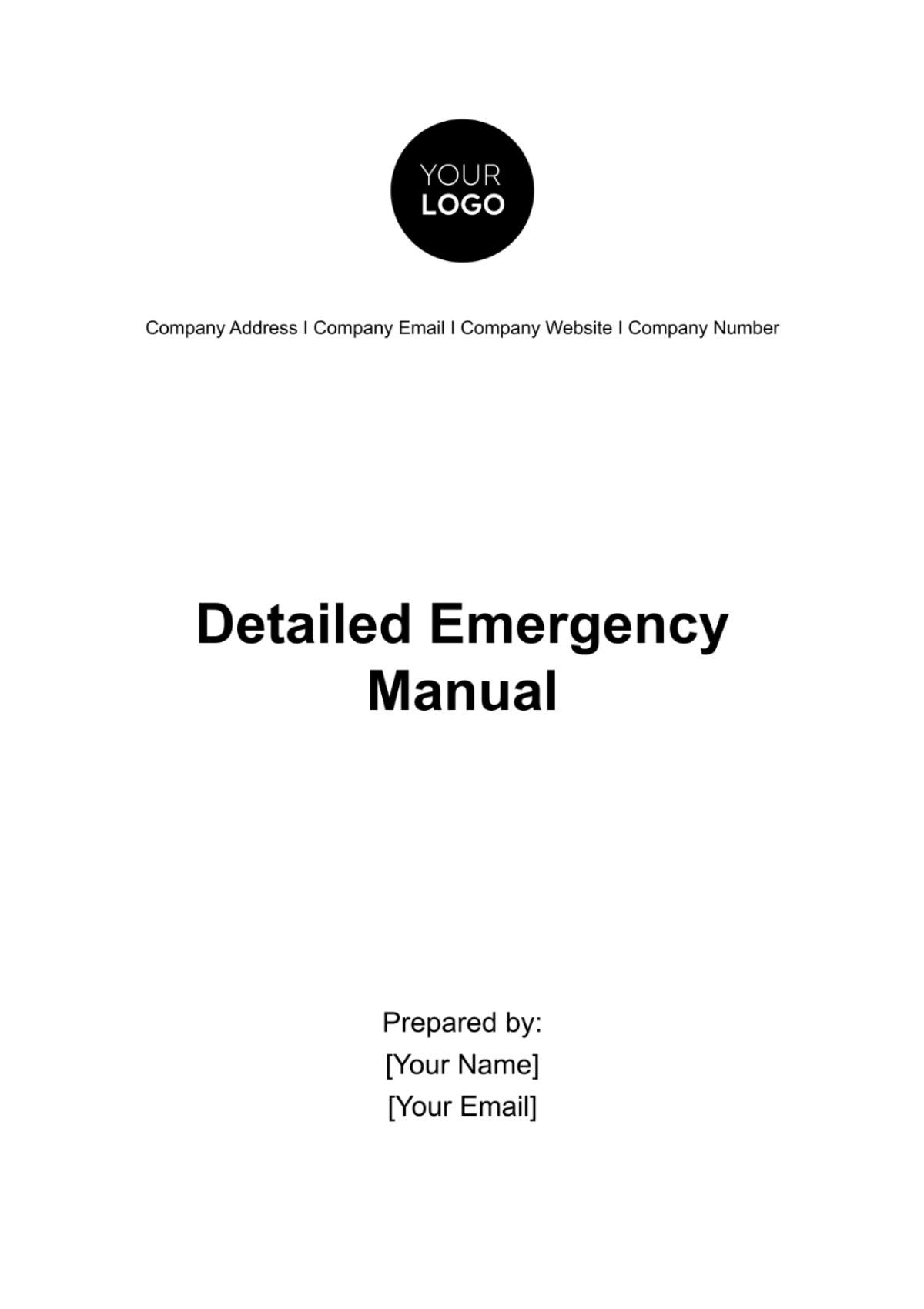Free Detailed Emergency Manual

A. Introduction and Purpose
This manual serves as a vital resource to ensure the safety and well-being of our employees, visitors, and the environment. Our commitment to a safe working environment is paramount, and this manual plays a crucial role in achieving that goal.
The purpose of this manual is to provide clear and comprehensive guidance on how to respond effectively to various emergency situations that may arise in the workplace. It outlines the procedures and protocols necessary to protect lives, minimize injuries, and mitigate potential damage to property. By familiarizing yourself with the contents of this manual, you contribute to creating a safer and more secure environment for everyone at [Your Company Name].
B. Emergency Contacts
In case of an emergency, it is crucial to have quick access to the following contacts for immediate assistance. Please refer to the table below for the list of essential emergency contacts:
Contact Type | Name | Phone Number | Email Address |
Internal Emergency | [Name] | [Number] | [Email] |
Note: Ensure to dial [911] for immediate assistance in life-threatening situations. For other emergencies within our premises, contact the designated internal responders listed above. Please keep this information readily accessible and up-to-date, as it is crucial for the safety and security of all personnel at [Your Company Name].
C. Emergency Notification Procedures
Prompt and effective communication is essential during emergencies. This section outlines the procedures for notifying the relevant personnel and authorities. Follow these steps to ensure timely and accurate emergency notifications:
Clear and efficient communication is vital in managing emergencies, ensuring everyone's safety
D. Emergency Evacuation Procedures
In the event of an emergency that necessitates evacuation, it is crucial to have a well-defined plan in place. This section outlines the procedures to follow for a safe and orderly evacuation of our premises.
By following these evacuation procedures, we can minimize risks and prioritize everyone's safety. Regular drills and awareness are crucial to ensuring a swift and orderly evacuation in emergencies. Your cooperation is greatly appreciated.
E. Fire Safety
This section provides essential guidelines to prevent fires and respond effectively in case of a fire emergency. Here are five key fire safety measures:
Fire Safety Measures | Guidelines |
Preventive Measures |
|
Fire Detection and Alarm Systems |
|
Evacuation Procedures |
|
Fire Extinguisher Use |
|
Emergency Contact |
|
F. Medical Emergencies
In the event of a medical emergency, it is crucial to respond swiftly and appropriately. This section provides guidance on how to handle medical emergencies within our premises. Here are the key steps to follow:
Medical Emergency Response | Guidelines |
Assess the Situation |
|
Administer First Aid |
|
Contact Emergency Team |
|
Communicate with Victim |
|
G. Natural Disasters
Natural disasters, though rare, require a well-prepared response to minimize risks and protect lives. This section outlines our procedures in the event of natural disasters. Here are five key steps to follow:
Natural Disasters | Guidelines |
Earthquake Preparedness |
|
Hurricane and Flood Preparedness |
|
Tornado Preparedness |
|
Wildfire Preparedness |
|
Extreme Heat Preparedness |
|
H. Hazardous Materials
Handling hazardous materials requires utmost caution and adherence to safety protocols. This section provides guidance on managing hazardous materials safely within our premises. Here are five key steps to ensure the safe handling of hazardous materials:
Hazardous Materials Handling | Guidelines |
Identify Hazardous Materials |
|
Personnel Training |
|
Handling and Storage |
|
Spill Response and Cleanup |
|
Emergency Contact |
|
I. Security Threats
Maintaining a secure workplace is essential for the safety of our employees and assets. This section outlines procedures for responding to security threats effectively. Here are five key steps to ensure security in our premises:
Security Threat Response | Guidelines |
Threat Identification |
|
Emergency Lockdown |
|
Communication |
|
Evacuation if Necessary |
|
Post-Incident Actions |
|
J. Drills and Training
Regular drills and training are fundamental to ensuring that our employees are well-prepared to respond effectively in emergency situations. This section outlines the importance of drills and the training programs we provide to enhance safety awareness and response capabilities.
Importance of Drills and Training
Drills and training programs are crucial for several reasons:
Familiarization: They help employees become familiar with emergency procedures, equipment, and evacuation routes.
Skill Development: Regular training enhances skills such as first aid, fire extinguisher use, and hazard recognition.
Emergency Response: Drills simulate real-life scenarios, ensuring employees know how to react calmly and efficiently in emergencies.
Communication: They improve communication and coordination among employees, enabling a cohesive response.
Compliance: Training ensures that our workplace remains compliant with safety regulations and standards.
Training Programs Offered
We provide the following training programs to equip employees with the knowledge and skills needed for various emergency situations:
Emergency Evacuation: Training on safe evacuation procedures and assembly point locations.
First Aid and CPR: Instruction on providing basic medical assistance in emergencies.
Fire Safety: Education on fire prevention, response, and the proper use of fire extinguishers.
Hazardous Materials: Training for handling hazardous materials safely.
Security Awareness: Enhancing employees' ability to identify and respond to security threats.
Natural Disaster Preparedness: Education on responding to earthquakes, hurricanes, tornadoes, and other natural disasters.
Participation in these training programs and drills is mandatory to ensure the safety and well-being of all employees and visitors. We appreciate your commitment to maintaining a safe workplace.
- 100% Customizable, free editor
- Access 1 Million+ Templates, photo’s & graphics
- Download or share as a template
- Click and replace photos, graphics, text, backgrounds
- Resize, crop, AI write & more
- Access advanced editor
Easily prepare for emergencies with Template.net's Detailed Emergency Manual Template. This editable and customizable resource, powered by our Ai Editor Tool, offers a comprehensive solution for crafting precise emergency plans tailored to your organization's needs. Safeguard your team and assets with Template.net's innovative approach to emergency preparedness.





























